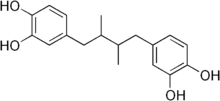Nordihydroguaiaretic acid
 | |
| Names | |
|---|---|
| IUPAC name
4,4'-(2,3-Dimethylbutane-1,4-diyl)dibenzene-1,2-diol | |
| Identifiers | |
3D model (JSmol) |
|
| ChEBI | |
| ChEMBL | |
| ECHA InfoCard | 100.007.185 |
| MeSH | Nordihydroguaiaretic+acid |
PubChem CID |
|
| |
| Properties | |
| C18H22O4 | |
| Molar mass | 302.37 g·mol−1 |
Except where otherwise noted, data are given for materials in their standard state (at 25 °C [77 °F], 100 kPa). | |
| Infobox references | |
Nordihydroguaiaretic acid (NDGA) is an antioxidant compound found in the creosote bush (Larrea tridentata).
The creosote plant has been used in herbal medicine, but its use is controversial. It was widely used during the 1950s as a food preservative and to preserve natural fibers, but was later banned after reports of toxicity during the early 1960s. Recently, it has been used as a nutritional supplement; however, renal toxicity and hepatotoxicity are reported for chronic use of creosote bush and NDGA.[1][2][3]
A 1986 study involved feeding female mosquitos NDGA to test the effect on their average life span. While the usual mosquito life span was 29 days, the NDGA-fed mosquitos lived an average of 45 days—an increase of 50 percent.[4] A 2008 study reported that nordihydroguaiaretic acid lengthened the lifespan of male mice, but not of female mice.[5]
See also
- Masoprocol, an antineoplastic drug used to treat skin growths caused by sun exposure.
References
- ↑ Arteaga, S.; Andrade-Cetto, A.; Cárdenas, R. (2005). "Larrea tridentata (Creosote bush), an abundant plant of Mexican and US-American deserts and its metabolite nordihydroguaiaretic acid". Journal of Ethnopharmacology. 98 (3): 231–239. doi:10.1016/j.jep.2005.02.002. PMID 15814253.
- ↑ Sahu, S. C.; Ruggles, D. I.; o’Donnell, M. W. (2006). "Prooxidant activity and toxicity of nordihydroguaiaretic acid in clone-9 rat hepatocyte cultures". Food and Chemical Toxicology. 44 (10): 1751–7. doi:10.1016/j.fct.2006.05.016. PMID 16839654.
- ↑ Lambert, J. D.; Zhao, D; Meyers, R. O.; Kuester, R. K.; Timmermann, B. N.; Dorr, R. T. (2002). "Nordihydroguaiaretic acid: Hepatotoxicity and detoxification in the mouse". Toxicon. 40 (12): 1701–8. doi:10.1016/s0041-0101(02)00203-9. PMID 12457882.
- ↑ Richie Jr, J. P.; Mills, B. J.; Lang, C. A. (1986). "Dietary nordihydroguaiaretic acid increases the life span of the mosquito". Proceedings of the Society for Experimental Biology and Medicine. Society for Experimental Biology and Medicine. 183 (1): 81–85. doi:10.3181/00379727-183-42389. PMID 3749035.
- ↑ Strong, R.; Miller, R. A.; Astle, C. M.; Floyd, R. A.; Flurkey, K.; Hensley, K. L.; Javors, M. A.; Leeuwenburgh, C.; Nelson, J. F.; Ongini, E.; Nadon, N. L.; Warner, H. R.; Harrison, D. E. (2008). "Nordihydroguaiaretic acid and aspirin increase lifespan of genetically heterogeneous male mice". Aging Cell. 7 (5): 641–650. doi:10.1111/j.1474-9726.2008.00414.x. PMC 2695675. PMID 18631321.